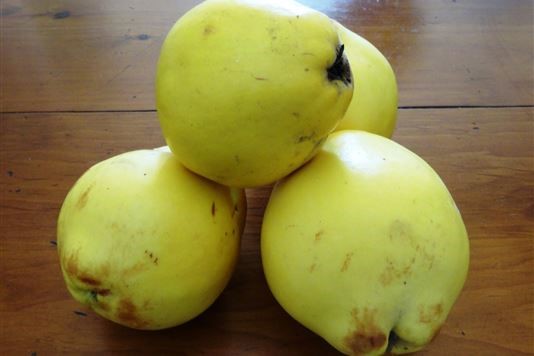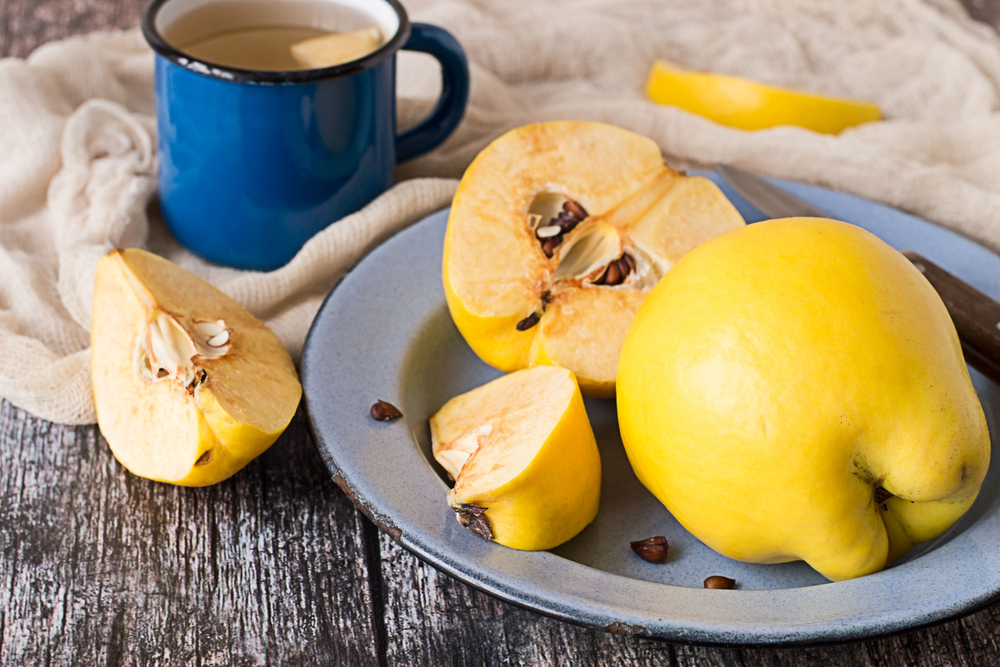How to cook with quince

Quinces are woody and sour when raw, but a little effort spent in cooking this overlooked fruit makes a lot of difference.
Quince trees can grow up to eight metres high, depending on the variety, and are related to apples, pears and roses (perhaps the last on this list explains the fruit’s fragrant perfume). They are native to southwest Asia, Turkey and Iran but are now grown in far more countries.
When really fresh, quinces have a velvet downy coating, underneath which is a waxy, golden-yellow skin.
What's their history?
Since it is believed that the quince preceded the apple, it's possible that the fateful apple from the Garden of Eden was in fact a quince, that the golden apple given to Aphrodite by Paris was a quince, and that the golden apple used by Hippomenes to distract Atlanta from winning the race, so that he could marry her, was also a quince.
In Ancient Greece the quince became known as the fruit of love, marriage and fertility and was nibbled by new brides to sweeten their breath. In 1275, Edward I had four quince trees planted in the grounds of the Tower of London.
Edward Lear, the English poet and artist loved for his nonsense rhymes, wrote The Owl and the Pussycat, first published in 1871. Most of us will remember that after the owl and the pussycat sailed away for a year and a day, ‘they dined on mince and slices of quince’.
 elizaveta66/Shutterstock
elizaveta66/Shutterstock
Are quinces good for you?
There are many purported health benefits associated with the quince.
Chief among these are the fruit’s high levels of antioxidants and Vitamin C, plus the anti-inflammatory properties of the seeds.
Some luxury skincare products use quince-seed extract for its soothing properties, as well as quince wax which is believed to protect human skin.
Where can you find them?
Quinces can be found in many independent grocery shops – or purchased from online retailers.
It would be easy to mistake quinces for giant oversized yellow apples, but pick one up and have a sniff: it has an unexpected apple and rose-like fragrance.
If you're really keen, quince trees are easy to buy on the internet.
 Pixabay
Pixabay
How do you prepare quince?
Raw quinces are too hard, dry and sour to eat, as they are usually picked before full ripeness.
Poach them and they soften, sweeten and turn a beautiful pale pink. In fact, the longer you cook quinces the darker their colour turns, and they have that appealing graininess you find in pears. A top tip when poaching quince is to always add a couple of star anise, as it's a fabulous spice in both sweet and savoury dishes. You can add whatever other spices you fancy, such as cinnamon, cloves or vanilla.
Bake them as you would a baked apple, in a medium oven with plenty of sugar, until tender. Either halved or in slices works well.
Stew them by simmering slowly for a long time. Once they're starting to soften you can also add in cooking apples to lighten the flavour.
 marketlan/Shutterstock
marketlan/Shutterstock
What dishes can quince be used in?
Quinces are packed with pectin so historically have been used for jams and jellies. The most famous quince dish, which you may see at your supermarket on the cheese counter, is 'membrillo', also known as quince cheese. It's a Spanish paste classically paired with Manchego cheese.
Because of their fragrance, a few pieces of quince also work well added to enrich apple pie or you can simply eat poached quince with Greek yoghurt.
Ready to get cooking? Try this recipe for poached quince with spiced syrup or use pre-made membrillo in this recipe for quince and pomegranate glazed pork
This article was first published in 2014 and updated in October 2017
You might also like:
Comments
Do you want to comment on this article? You need to be signed in for this feature